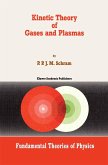Kinetic Theory: Classical, Quantum, and Relativistic Descriptions goes beyond the scope of other works in the field with its thorough treatment of applications in a wide variety of disciplines. Its clear exposition and emphasis on concrete examples will make it not only an excellent graduate text but also a valuable resource for researchers in such disciplines as aerospace, mechanical, and chemical engineering; astrophysics, solid state and laser physics and devices, plasma physics, and controlled and thermonuclear fusion.
Among the topics covered are:
- The Liouville equation and analyses of the Liouville equation, including two independent derivations
- The Boltzmann equation and Boltzmann's H-theorem
- Analysis of the linearized collision operator
- Fluid dynamics and irreversibility
- Assorted kinetic equations with applications to plasmas and neutral fluids
- Elements of quantum kinetic theory, including the Green's-function formalism and the Wigner-Moyal equation
- Relativistic kinetic theory and Lorentz invariants
- Kinetic properties of metals and amorphous media
- Monte-Carlo analysis in kinetic theory
- Kinetic study of shock waves
This third revised edition features a new section on constants of motion and symmetry and a new appendix on the Lorentz-Legendre expansion.
Among the topics covered are:
- The Liouville equation and analyses of the Liouville equation, including two independent derivations
- The Boltzmann equation and Boltzmann's H-theorem
- Analysis of the linearized collision operator
- Fluid dynamics and irreversibility
- Assorted kinetic equations with applications to plasmas and neutral fluids
- Elements of quantum kinetic theory, including the Green's-function formalism and the Wigner-Moyal equation
- Relativistic kinetic theory and Lorentz invariants
- Kinetic properties of metals and amorphous media
- Monte-Carlo analysis in kinetic theory
- Kinetic study of shock waves
This third revised edition features a new section on constants of motion and symmetry and a new appendix on the Lorentz-Legendre expansion.
From the reviews of the third edition:
"This monograph is devoted to a standard approach of kinetic theory in classical and quantum systems. ... The book is divided in 7 chapters; each of them is ended by a set of interesting problems of different difficulties. The presentation is clear ... . The book includes also tables and figures that make more pleasant its reading. ... this book gives a standard presentation of kinetic theory; one of its qualities is to provide clear calculations and a good overview of classical methods." (Stéphan Métens, Physicalia, Vol. 57 (3), 2005)
"Liboff's book on kinetic theory, now in its third edition, is a gulf apart from standard treatments one encounters in statistical and thermal physics texts. ... This text will be suitable for students and researchers ... . Students will welcome the good number of problems at the end of each chapter, some of which having detailed solutions." (J. Hartley, Contemporary Physics, Vol. 45 (5), 2005)
"This monograph is devoted to a standard approach of kinetic theory in classical and quantum systems. ... The book is divided in 7 chapters; each of them is ended by a set of interesting problems of different difficulties. The presentation is clear ... . The book includes also tables and figures that make more pleasant its reading. ... this book gives a standard presentation of kinetic theory; one of its qualities is to provide clear calculations and a good overview of classical methods." (Stéphan Métens, Physicalia, Vol. 57 (3), 2005)
"Liboff's book on kinetic theory, now in its third edition, is a gulf apart from standard treatments one encounters in statistical and thermal physics texts. ... This text will be suitable for students and researchers ... . Students will welcome the good number of problems at the end of each chapter, some of which having detailed solutions." (J. Hartley, Contemporary Physics, Vol. 45 (5), 2005)








